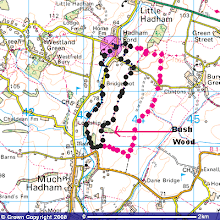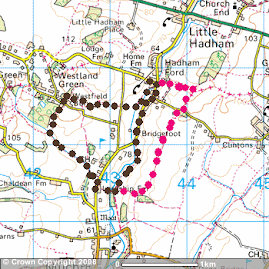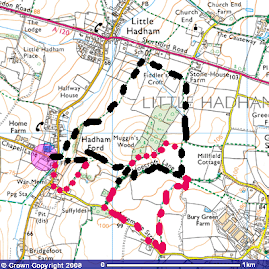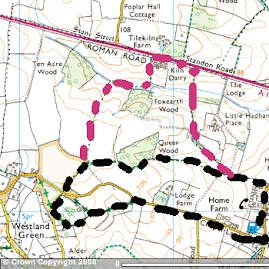For bird watchers and all round naturalists March is an exciting month as summer migrants begin to arrive, insects emerge from pupation or hibernation, plants begin to flower and the leaves on the trees begin to open, along with the blossom on prunus and apple species and on willow species.
Here are a few things to look out for over the next 4 weeks.
On willow trees (sallows) the feathery flowers will be in bud at present and a few warmer days will get them opening. A vital nectar supply for bees during the day and Orthosia moth species by night. If you have a flowering willow nearby, pop out with a torch on a warm night to check for moths such as Common quaker, Small quaker, Hebrew character and the inappropriately named Clouded drab. Other species also possible.
 |
| Common quaker |
 |
| Hebrew character |
 |
| Small quaker |
On warmer days, usually in the afternoon when temperatures reach their highest a few butterfly species should be on the wing. So far I have recorded both Peacock and Brimstone but these will be joined by Small tortoiseshell and Red admirals. These are butterflies that have hibernated over winter in trees, sheds, outhouses and homes and often a day time temperature in excess of 13C-14C will have them winging around gardens. Very little for them to feed on, so plenty of flying but not so easy to get a photo.
 |
| Brimstone, male yellow, female green. |
 |
| Red admiral |
 |
Small tortoiseshell (top) and Peacock.
|
There will be both a departure and arrival of birds. Winter visitors such as Siskin, Lesser redpoll, Fieldfare and Redwing can be found in large feeding flocks. The first two finch species are frequently seen on alders, such as along the Stort and at Rushy Mead whilst the thrushes are now feeding on the ground as they will have finished most of the berries that sustained them through the winter. Any open grassland habitat will offer a chance to see these in good number. Over 350 Fieldfare usually congregate on the 9 hole par 3 course at Ash Valley GC. When not hopping along the ground they can be seen on tree tops, the familiar "chack chack" call of the Fieldfare is far ranging. These bird numbers will be augmented by birds such as Blackbirds and Jays that also came across the North Sea, so for a while it may appear on local bird walks that many of the birds have disappeared.
Birds such as Nuthatch and Coal tit that may have been over wintering in gardens where there were feeders will now be re-locating to woodland areas for breeding.
Gull species will be heading off to their breeding grounds, too, so fewer numbers of these instantly recognisable birds in fields and moving overhead in towns.
Great Spotted and Lesser spotted woodpeckers will be drumming. This is a territorial method of announcing their ownership of a part of a woodland, not hollowing out a nest hole. Basically, the GSW drums for half the time a LSW does. An old bird watcher I knew back in the 60's and 70's told me if it is still drumming after you have said "Greater spotted woodpecker" then it is an LSW! If you do come across what you think maybe a LSW drumming I would be very interested to hear about it as they are very few and far between around East Herts. Don't worry if you're not sure. Happy to check even if it turns out to be a GSW.
Tawny owls and Little owls will become increasingly noisy after dusk and can offer the best chance of finding them. Barn owls will be feeding before dusk and after daybreak so a drive around country lanes is always a worthwhile activity in March.
The first arrivals are invariably Chiffchaffs and Sand martins. The former will arrive and almost immediately set up a territory by calling their recognizable "zip zap" or "chiffchaff" call. Usually in woodland areas and a warm spring day it will be possible to encounter a fair few calling.
Sand martins are birds of water habitats, similar to house martins but with brown wings and a brown band across the breast. No white rump either, as in house martin. They are usually first seen at Amwell before they disperse to their breeding sites, sandy banks into which they scratch a tunnel. Always a chance of a small party of them moving north up river courses, especially the Stort from Sawbridgeworth to Stortford.
 |
| Chiffchaff |
 |
| Little owl |
 |
| Barn owl |
 |
| Siskin |
 |
| Fieldfare |
 |
| Redwing (note white eye stripe) |
Bee, beetle and bug species will start to emerge and a quick search of any flowers will offer a good chance of finding some species.
The Dark edged Bee Fly is often the first to catch the eye with its long needle like proboscis. A harmless creature and one that will be everyone's garden before the end of the month, if we have some decent temperatures.
 |
| Dark edged bee fly |
Bees will begin to be noted on blossom of prunus species as well as any early apple blossom but always worth checking any flowering plant for these. Some will be the small Andrena species, of which there are over 50 and pretty tricky to id. Photos really helpful for this.
Larger bumblebees will be easier to spot and identify. Presently, mainly Queens out of hibernation that will find a regular food source before prospecting for nesting sites. The most common will be Bombus terristris, the Buff tailed bumble bee. In early spring they can be quite passive and easy to get a good photo of for id.
If you have holes in a brick wall or in trees check these for the Hairy footed Flower be trying to squash into them to lay her eggs.
7 spot ladybirds and the black with 2 red spots Pine ladybird are invariably out in March. The former is in huge numbers in my garden, with over 50 counted last weekend in the warmer weather. A few hoverfly species, too should be found on flowering plants and blossom. These tricky to id family of Diptera can be narrowed down to one of just a few species due to how early it is in the year and will probably be Eristalis pertinax, a dark hoverfly with a couple of yellow/orange bands near the thorax. Another possibility is the smaller Episyrphus balteatus The Marmalade Fly. This is banded all the way along the abdomen with tell tale white hoops between the black and the orange.
 |
| Bombus terristris, Buff tailed bumble bee |
 |
| Andrena bicolor, Gwynne's Mining bee |

|
Anthophora plumipes (Hairy footed Flower bee)
|
 |
| Episyrphus balteatus, here caught by a Misumena vatia spider. |
A reasonably easy hoverfly to identify.
 |
| Eristalis pertinax hoverfly |
Mammals will become more apparent with Muntjac barking heard every night whilst badgers and foxes will be soon with cubs and always a chance of seeing then out in daylight, particularly foxes.
Hares will be seen in good numbers in the correct habitat with their Boxing antics always amusing to observe. Open grassland is best but they can be found in larger groups on emerging cereal fields, too.
Finally, the dawn and dusk choruses will increase in tempo as we move through March. A bright early morning start around 6.00 - 6.30am will give a good opportunity to hear: Robin, Blackbird, Song thrush, Mistle thrush, Dunnock, Chaffinch and Goldfinch in good voice. Wrens will join in, too. With a little study the bird and its song can be matched relatively easily.
As always, happy to help with id's of anything folk encounter and if I am not sure, I know several experts who certainly will do. The Stortford Nature FB account was great for this last spring and summer and if we share our findings it will help others identify things as well. Doesn't matter how common you think it maybe, it will be something new for someone here so will be really helpful.





























































